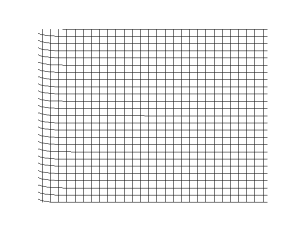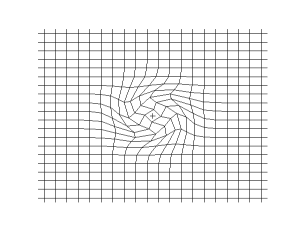|
|
S-wave
Plane shear wave
Propagation of a spherical S-wave in a 2d grid (empirical model)S-wave can also refer to the lowest energy electronic wavefunction in atomic physics; see atomic orbital.
A type of seismic wave, the S-wave, secondary wave, or shear wave (sometimes called an elastic S-wave) is one of the two main types of elastic body waves, so named because they move through the body of an object, unlike surface waves.
The S-wave move as a shear or transverse wave, so motion is perpendicular to the direction of wave propagation: S-waves, like waves in a rope, as opposed to waves moving through a slinky, the P-wave. The wave moves through elastic media, and the main restoring force comes from shear effects. These waves are divergenceless and obey the continuity equation for incompressible media:


The shadow zone of a P-wave. S-waves don't penetrate the outer core, so they're shadowed everywhere more than 104° away from the epicenter (from USGS)Its name, S for secondary, comes from the fact that it is the second direct arrival on an earthquake seismogram, after the compressional primary wave, or P-wave, because S-waves travel slower in rock. Unlike the P-wave, the S-wave cannot travel through the molten outer core of the Earth, and this causes a shadow zone for S-waves opposite to where they originate. They can still appear in the solid inner core: when a P-wave strikes the boundary of molten and solid cores, called the Lehmann discontinuity, S-waves will then propagate in the solid medium. And when the S-waves hit the boundary again they will in turn create P-waves. In fact, this property allows seismologists to determine the nature of the inner core.
As transverse waves, S-waves exhibit properties, such as polarization and birefringence, much like other transverse waves. S-waves polarized in the horizontal plane are classified as SH-waves. If polarized in the vertical plane, they are classified as SV-waves. When an S- or P-wave strikes an interface at an angle other than 90 degrees, a phenomenon known as mode conversion occurs. As described above, if the interface is between a solid and liquid, S becomes P or vice versa. However, even if the interface is between two solid media, mode conversion results. If a P-wave strikes an interface, four propagation modes may result: reflected and transmitted P and reflected and transmitted SV. Similarly, if an SV-wave strikes an interface, the same four modes occur in different proportions. The exact amplitudes of all these waves are described by the Zoeppritz equations, which in turn are solutions to the wave equation. S-waves are slower than P-waves.
Theory
The prediction of S-waves came out of theory in the 1800s. Starting with the stress-strain relationship for an isotropic solid:
Newton's 2nd law in this situation gives the homogeneous equation of motion for seismic wave propagation:
where ρ is the mass density. Plugging in what the stress tensor is above gives:
Applying vector identities and making certain approximations gives the seismic wave equation in homogeneous media:
where Newton's notation has been used for the time derivative. Taking the curl of this equation and applying vector identities eventually gives:
which is simply the wave equation applied to the curl of u with a velocity β satisfying
This describes S-wave propagation. Taking the divergence of seismic wave equation in homogeneous media instead of the curl, yields an equation describing P-wave propgation.
Further reading
Shearer, Peter (1999). Introduction to Seismology (1st ed. ed.)Cambridge University Press. ISBN 0-521-66023-8.
Aki, Keiti; Richards, Paul G. (2002). Quantitative seismology (2nd ed. ed.). University Science Books. ISBN 0-935702-96-2.
Fowler, C. M. R. (1990). The solid earth. Cambridge, UK: Cambridge University Press. ISBN 0-521-38590-3.
[hide]v • d • eTopics in geotechnical engineering
Soils Clay · Silt · Sand · Gravel · Peat · Loam
Slope stability Hydraulic conductivity · Water content · Void ratio · Bulk density · Thixotropy · Reynolds' dilatancy · Angle of repose · Cohesion · Porosity · Permeability · Specific storage
Soil mechanics Effective stress · Pore water pressure · Shear strength · Overburden pressure · Consolidation · Soil compaction · Soil classification · Shear wave · Lateral earth pressure
Geotechnical investigation Cone penetration test · Standard penetration test · Exploration geophysics · Monitoring well · Borehole
Laboratory tests Atterberg limits · California bearing ratio · Direct shear test · Hydrometer · Proctor compaction test · R-value · Sieve analysis · Triaxial shear test · Hydraulic conductivity tests · Water content tests
Field tests Crosshole sonic logging · Nuclear Densometer Test
Foundations Bearing capacity · Shallow foundation · Deep foundation · Dynamic load testing · Wave equation analysis
Retaining walls Mechanically stabilized earth · Soil nailing · Tieback · Gabion · Slurry wall
Mass wasting · Landslide · Slope stability analysis
Earthquakes Soil liquefaction · Response spectrum · Seismic hazard · Ground-structure interaction
Geosynthetics Geotextile · Geomembranes · Geosynthetic clay liner · Cellular confinement
Instrumentation for Stability Monitoring Deformation monitoring · Automated Deformation Monitoring
纵波,compressional wave,
横波,shear wave, |
|